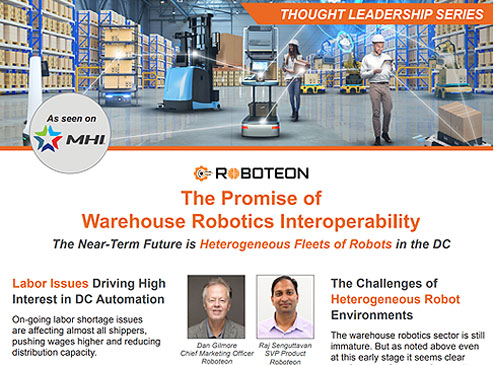What is a Multiagent Orchestration Platform?

We have entered the warehouse robotics era. And it will be powered by software.
Consider this: Amazon by itself deployed about 750,000 in 2023 alone, up 40% from 2022, according to an article on April, 2024 by Yahoo Finance.
That’s a lot of robots.
While there are many types of warehouse robots (Amazon said in recent blog post latest design incorporates eight different styles), there has been special interest in what are called Autonomous Mobile Robots (AMRs).
As the name suggests, AMRs travel without human assistance throughout a distribution center, executing a variety of task types, from basic transport functions to collaborative picking in conjunction with human workers.
However, as with nearly all forms of warehouse automation, warehouse robotics is highly dependent on robust software for ultimate success.
Which begs the question: just what is the software that manages and optimizes warehouse robotic performance?
While each AMR provider will have its own fleet management system, that is often limited to the basic functions of mapping a facility and then safely navigating the robots from point A to B to execute tasks assigned by some other software application.
That challenge exists for deployment of a single fleet of AMRs from one vendor. The challenge becomes even greater if a company also moves to deploy robots from a different AMR vendor or of a different robot type.
The analysts at Gartner® expect that: “as companies expand their robotics usage, most will eventually have heterogeneous fleets of robots from different vendors performing various tasks, which will require standardized software that can easily integrate into a variety of agents and robot platforms.”
About three years ago, Gartner coined a term to capture the new type of warehouse automation management software that will be required for success.
That Garner term is this: Multiagent Orchestration platform, or MAO.
While Gartner notes MAO is an evolving concept, in mid-2024 it updated its definition, as follows:
“Multiagent orchestration platforms (MAO platforms) act like intelligent middleware that integrates and orchestrates work between various business applications, heterogeneous fleets of operational robots, and other automated agents like doors or elevators. These solutions orchestrate and assign work, and monitor and coordinate the activities of diverse fleets of robots.”*
It adds that “These solutions will assign work to the right robots based on the characteristics of immediate and prioritized tasks and communicate with other types of automation (agents) like door or elevator controls.”
So if you are potentially interested in warehouse robotics, it may benefit you to understand the Multiagent Orchestration platform concept if it is not currently part of your lexicon.
Since our founding in late 2022, Roboteon’s Robotics Fulfillment Platform capabilities have tracked the evolution of the MAO definition very closely, and in many cases exceeding them, delivering what we sometimes refer to as “MAO+.”
That includes integration, management, orchestration, and optimization of robot-enabled warehouse processes, advanced use of AI and simulation, and more.
You can learn more about that platform here.
We would welcome the chance to discuss your robotic challenges and opportunities soon.
*Gartner Research Note: Hype Cycle for Mobile Robots and Drones, 2024, June 25, 2024. GARTNER is a registered trademark and service mark of Gartner, Inc. and/or its affiliates in the U.S. and internationally and is used herein with permission. All rights reserved.
FEATURED BLOG

Roboteon Quoted in an Article on Warehouse Automation by Modern Materials Handling
READ MORENEWS
Roboteon and Stellium announce Strategic Partner Partnership for Robotics and Automation Solutions for SAP EWM using Roboteon’s Multi-Agent Orchestration Platform
LEARN MOREMeet Roboteon at SAP Sapphire in Orlando
LEARN MOREWell-Known Former Gartner Analyst Dwight Klappich Joins Roboteon as Strategic Advisor
LEARN MOREResources

Thought Leadership Series: The Promise of Warehouse Robotics Interoperability
DOWNLOAD REPORT
Understanding Warehouse Robotics Software - White Paper
DOWNLOAD REPORT
Roboteon Solution Overview
Watch Video